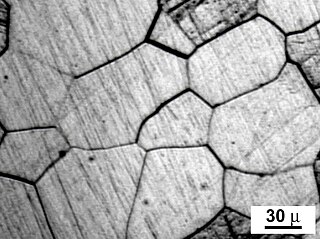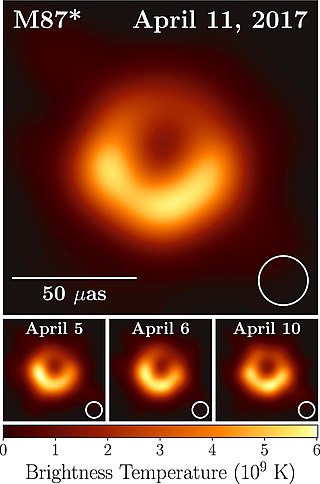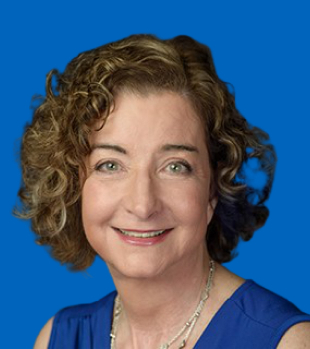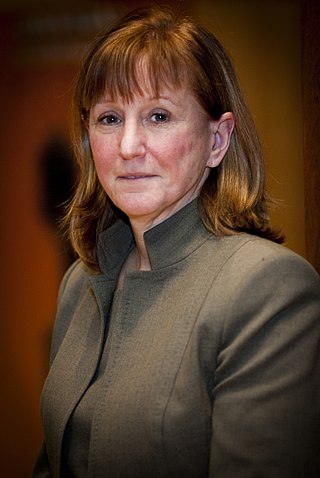Related Research Articles

A crystallite is a small or even microscopic crystal which forms,for example,during the cooling of many materials. Crystallites are also referred to as grains.

In materials science,a grain boundary is the interface between two grains,or crystallites,in a polycrystalline material. Grain boundaries are two-dimensional defects in the crystal structure,and tend to decrease the electrical and thermal conductivity of the material. Most grain boundaries are preferred sites for the onset of corrosion and for the precipitation of new phases from the solid. They are also important to many of the mechanisms of creep. On the other hand,grain boundaries disrupt the motion of dislocations through a material,so reducing crystallite size is a common way to improve mechanical strength,as described by the Hall–Petch relationship.
In metallurgy,materials science and structural geology,subgrain rotation recrystallization is recognized as an important mechanism for dynamic recrystallisation. It involves the rotation of initially low-angle sub-grain boundaries until the mismatch between the crystal lattices across the boundary is sufficient for them to be regarded as grain boundaries. This mechanism has been recognized in many minerals and in metals.

Feryal Özel is a Turkish-American astrophysicist born in Istanbul,Turkey,specializing in the physics of compact objects and high energy astrophysical phenomena. As of 2022,Özel is the Department Chair and a professor at the Georgia Institute of Technology School of Physics in Atlanta. She was previously a professor at the University of Arizona in Tucson,in the Astronomy Department and Steward Observatory.

Amit Goyal is a SUNY Distinguished Professor and a SUNY Empire Innovation Professor at SUNY-Buffalo. He leads the Laboratory for Heteroepitaxial Growth of Functional Materials &Devices. He is also Director of the New York State Center of Excellence in Plastics Recycling Research &Innovation,an externally funded center with initial funding of $4.5M for three years at SUNY-Buffalo. He is the founding director of the multidisciplinary and transdisciplinary RENEW Institute at SUNY-Buffalo in Buffalo,New York and served as director from 2015-2021. RENEW is an internally funded research institute at SUNY-Buffalo. For his contributions to UB,in 2019,he was awarded the University at Buffalo or SUNY-Buffalo President's Medal,which recognizes “outstanding scholarly or artistic achievements,humanitarian acts,contributions of time or treasure,exemplary leadership or any other major contribution to the development of the University at Buffalo and the quality of life in the UB community.”This is one of the highest recognitions given at the university.
Michael J. Shelley is an American applied mathematician who works on the modeling and simulation of complex systems arising in physics and biology. This has included free-boundary problems in fluids and materials science,singularity formation in partial differential equations,modeling visual perception in the primary visual cortex,dynamics of complex and active fluids,cellular biophysics,and fluid-structure interaction problems such as the flapping of flags,stream-lining in nature,and flapping flight. He is also the co-founder and co-director of the Courant Institute's Applied Mathematics Lab.

William David Kingery was an American material scientist who developed systematic methods for the study of ceramics. For his work,he was awarded the Kyoto Prize in 1999.
Merrill Brian Maple is an American physicist. He is a distinguished professor of physics and holds the Bernd T. Matthias Chair in the physics department at the University of California,San Diego,and conducts research at the university's Center for Advanced Nanoscience. He has also served as the director of UCSD's Institute for Pure and Applied Physical Sciences (1995-2009) and its Center for Interface and Materials Science (1990-2010). His primary research interest is condensed matter physics,involving phenomena like magnetism and superconductivity. He has authored or co-authored more than 900 scientific publications and five patents in correlated electron physics,high pressure physics,nano physics,and surface science.
James Arthur Krumhansl was an American physicist who specialized in condensed matter physics and materials science. He spent much of his career at Cornell University. He also served as president of the American Physical Society and assistant director for mathematics,physical sciences,and engineering for the National Science Foundation. In 1987 he testified before Congress that the Superconducting Super Collider would be too costly.

Laura H. Greene is the Marie Krafft Professor of Physics at Florida State University and chief scientist at the National High Magnetic Field Laboratory. She was previously a professor of physics at the University of Illinois at Urbana-Champaign. In September 2021,she was appointed to the President's Council of Advisors on Science and Technology (PCAST).
Kohji Kishio is a Japanese scientist. He retired from the University of Tokyo in March 2017 and is now Emeritus Professor of UT. His major research fields are Solid State Chemistry,Materials Science and Superconducting Materials Engineering. He is a Fellow of the Japan Society of Applied Physics.

David R. Clarke is a material scientist and the inaugural Extended Tarr Family Professor of Material Science and Applied Physics at Harvard John A. Paulson School of Engineering and Applied Sciences (SEAS). He is the principal investigator of the Materials Discovery and Applications Group.

Judith Louise MacManus-Driscoll is a Professor of Materials Science at the University of Cambridge. Driscoll is known for her interdisciplinary work on thin film engineering. She has a particular focus on functional oxide systems,demonstrating new ways to engineer thin films to meet the required applications performance. She has worked extensively in the fields of high temperature superconductors,ferroics and multiferroics,ionics,and semiconductors. She holds several licensed patents.

Renata Maria Mattosinho Wentzcovitch is a Brazilian/Italian American physicist. She was born in Campinas (SP) and grew up in the ABC region on the outskirts of São Paulo,Brazil. She is a faculty member of the Department of Applied Physics and Applied Mathematics and the Department of Earth and Environmental Sciences at Columbia University. She is also a senior staff scientist at the Lamont Doherty Earth Observatory,Columbia University. Before joining the Columbia University faculty,she worked for the University of Minnesota. She was a faculty member in the Department of Chemical Engineering and Materials Science and a member of the graduate faculties in the Department of Physics and Astronomy,Department of Earth and Environmental Sciences,Chemical Physics Program,and Computational Science Program. Her research focuses on developing and applying materials simulation methods at extreme pressure and temperature conditions,especially planet-forming materials. She is currently Vice-President of the Mineral and Rock Physics Section of the American Geophysical Union.

Katherine T. Faber is an American materials scientist and one of the world's foremost experts in ceramic engineering,material strengthening,and ultra-high temperature materials. Faber is the Simon Ramo Professor of Materials Science at the California Institute of Technology (Caltech). She was previously the Walter P. Murphy Professor and department chair of Materials Science and Engineering at the McCormick School of Engineering and Applied Science at Northwestern University.
Helen M. Chan is the New Jersey Zinc Professor at Lehigh University. Her work considers the development of ceramic-metal nanocomposites. She is on the board of directors of the American Ceramic Society.

Dawn Austin Bonnell is the Senior Vice Provost for Research at the University of Pennsylvania. She has previously served as the Founding Director of the National Science Foundation Nano–Bio Interface Center,Vice President of the American Ceramic Society and President of the American Vacuum Society. In 2024,she was elected to the American Philosophical Society.
Catherine Kallin is a Canadian theoretical quantum condensed matter physicist whose research topics have included spin wave theory,the quantum Hall effect,frustrated antiferromagnets,chirality in superconductors,and high-temperature superconductivity. She is a professor emerita of physics and astronomy at McMaster University.
Amalia Ioana Coldea is a Romanian quantum physicist who is Professor of Physics at the University of Oxford. She was awarded the 2019 Institute of Physics Brian Pippard Prize and the 2011 EuroMagnet Prize.
Elizabeth Carol Dickey is an American materials scientist who is the Teddy and Wilton Hawkins Distinguished Professor at Carnegie Mellon University. Her research considers structure-property relationships for materials with grain boundaries and interfaces. She is a Fellow of the American Association for the Advancement of Science,the American Ceramic Society and the Microscopy Society of America.
References
- 1 2 3 4 5 6 "Siu-Wai Chan". Columbia University. Retrieved 3 November 2024.
- 1 2 Report of the President and the Treasurer. John Simon Guggenheim Memorial Foundation. 2004. p. 55.
- ↑ "Crystallite rotations driven by the variation of grain boundary energy with misorientation". MIT Libraries. Retrieved 3 November 2024.
- ↑ "Siu-Wai Chan". John Simon Guggenheim Memorial Foundation. Retrieved 3 November 2024.
- ↑ "Fellows of The American Ceramic Society" (PDF). American Ceramic Society. Retrieved 3 November 2024.
- ↑ "APS Fellows Archive". American Physical Society. Retrieved 3 November 2024.